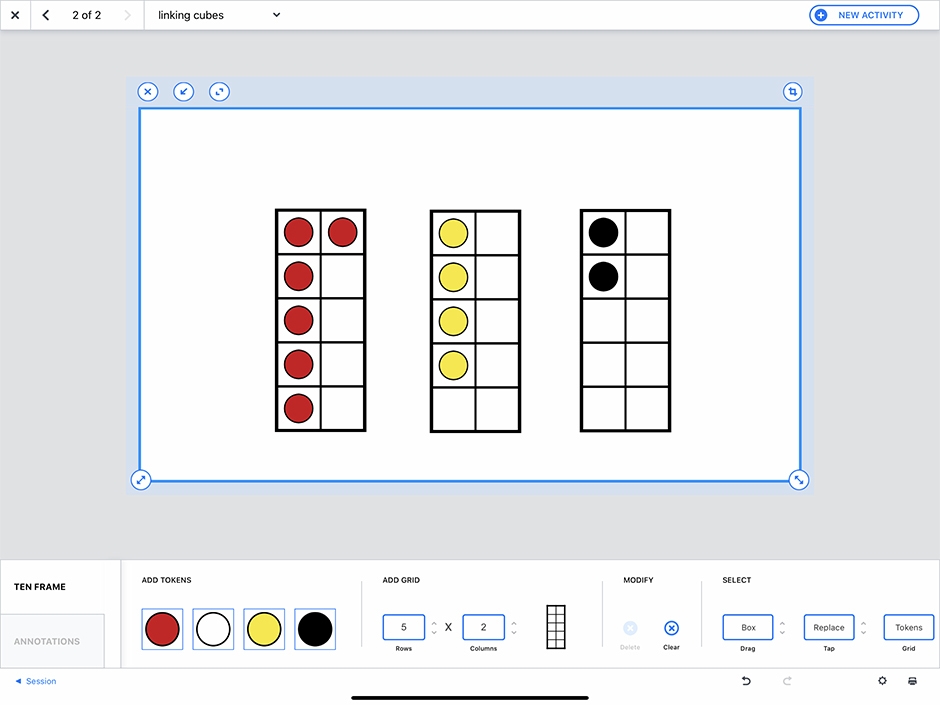What is Subitising? A hidden gem in developing mental arithmetic skills
When they practise subitising, children develop their ability to recognize and quickly comprehend the quantities of objects, a skill that can help them with mental calculations, estimation, and problem-solving.
In a world where calculators and smartphones have made mental arithmetic seem less important, it's crucial to remember the value of building strong foundational maths skills in children. One often overlooked method that can greatly improve mental arithmetic is subitising. In this blog post, we'll explore the concept of subitising, its connection to mental arithmetic and how you can help your child develop these essential skills.
Subitising plays an important role in how young children learn and is a key part of the requirements of the National Mathematics Curriculum. It is formally introduced in the Early Years Foundation Stage (EYFS), where children begin to develop this skill as part of learning number sense. By understanding and nurturing subitising skills, educators and parents can lay a strong foundation for a child's mathematical journey.
Understanding subitising
When they practise subitising, children develop their ability to recognise and quickly comprehend the quantities of objects through number patterns, a skill that can help them with mental calculations, estimation, and problem-solving.
What is subitising?
Subitising — from the Latin word meaning ‘suddenly’ — is the skill of instantly seeing how many items are in a group. For example, if I hold up my hand, you normally wouldn’t have to count my fingers and thumb to know it’s five. Most people can subitise as many as six or seven randomly arranged items.
In the EYFS, children typically start by subitising up to 5, gradually progressing to understanding numbers up to 10. This progression aligns with the development of their overall number sense and prepares them for more advanced mathematical concepts in later years.
Editor’s note: There are some exceptions. Read our ‘parents and teachers guide to identifying specific learning difficulties’ to learn more.
Difference between perceptual and conceptual subitising
There are two primary types of subitising: perceptual and conceptual. According to the website Early Math Counts, perceptual subitising is instantly knowing how many are in a given set, while conceptual subitising is the ability to see sets of numbers within larger sets, such as seeing two fours in the eight of a domino. If the number of items is too large to see all at once our brains ‘decompose’ the group into smaller chunks before adding them back together.
Here are some examples to illustrate these types:
- Perceptual Subitising: Quickly recognizing that there are four dots on a dice without counting
- Conceptual Subitising: Seeing a domino with 6 dots and instantly recognizing it as two groups of three
- Advanced Conceptual Subitising: Looking at a 10-frame with 7 counters and immediately seeing it as a full five and two more
The role of subitising in early years mathematics education
Sue Gifford at the University of Roehampton explains that subitising helps children build images for numbers, and visualise and learn number facts. Very young children are usually able to recognise the number of items in a group without having to count them. For instance, most four-year-olds recognise five dots on a dice, which helps them understand the cardinal value — or 'howmanyness' — of five. They can then link to the word ‘five’ and the numeric symbol ‘5.’
The Connection Between Subitising and Mental Arithmetic
How subitising develops number sense
Subitising is important because it helps children gain a deep understanding of quantity. Without an understanding of quantity, they may have no option but to count everything when they start to face more complex problems.
John Van de Walle, a prominent mathematics educator and author, emphasised the importance of subitising in developing number sense and mathematical fluency in young children. He said subitising lays the foundation for more advanced mathematical understanding by allowing children to grasp the concept of number as a quantity, rather than just a symbol or a sequence. By being able to recognize small groups of objects without counting, children can develop a strong sense of numbers and their relationships.
As children progress through Key Stage 2, their ability to subitise can significantly enhance their understanding and application of column addition and subtraction.
For example:
- Quick recognition of number bonds within 10 (developed through subitising) can speed up mental calculations in column addition.
- Understanding number composition (e.g., seeing 8 as 5 and 3) helps in regrouping during written subtraction.
- The ability to visualise quantities supports estimation skills, which are crucial for checking the reasonableness of answers in formal calculations.
The role of subitising in fostering mental arithmetic skills
There are several ways in which the skill of subitising contributes to the development of mental arithmetic abilities:
- Rapid recognition of small quantities: by instantly recognising quantities, children can perform mental calculations more rapidly, which leads to improved mental arithmetic skills
- Number combinations: subitising helps children develop an understanding of number combinations or number bonds. For example, when children are presented with the dots on a pair of dice, subitising allows them to see the numbers as parts that make up a whole, which supports mental arithmetic skills such as addition and subtraction
- Number decomposition: subitising helps in number decomposition, or breaking a number down into its parts. This allows children to quickly recognise different smaller groups within the larger set, which is crucial for mental arithmetic skills such as multiplication
- Mental estimation: by quickly perceiving quantities without counting, children can estimate the total number of objects or the result of an operation more effectively, which is a valuable skill in various mental arithmetic tasks that require approximations and quick calculations
- Building number sense: subitising supports the development of an intuitive understanding of numbers and their relationships
The link between subitising and other cognitive abilities
A strong understanding of numbers continues to develop over time through the exploration of numbers, visualising numbers and relating to numbers in different ways. Judy Hornigold provides this checklist for tracking how children are progressing with number sense:
- An awareness of the relationship between number and quantity
- An understanding of number symbols, vocabulary, and meaning
- The ability to engage in systematic counting, including notions of cardinality — knowing the symbol 4 denotes a group of four objects — and ordinality — knowing that 4 comes before 5 and after 3.
- An awareness of magnitude, or the ability to compare groups
- An understanding of different representations of number
- Competence with simple mathematical operations
Subitising is also linked to the following cognitive skills:
- Visual perception: the ability to discriminate and differentiate small groups of objects quickly
- Working memory: the ability to hold a mental representation of the quantity and rapidly process it
- Attention: the ability to focus attention on the visual stimuli and selectively attend to relevant information
- Numerical cognition: understanding and manipulating numerical quantities
- Executive functioning: a capacity for mental flexibility, inhibition of irrelevant information and cognitive control, which contribute to the development of executive functions involved in goal-directed behaviour, self-regulation, and problem-solving, since children must quickly process the quantity and inhibit the impulse to count
Become Qualified to Make a Difference
Empower yourself to create a lasting impact in pupils’ lives. Gain maths mastery certificates that will represent all you’ve accomplished and learned in your teaching journey.
From Fellow, to Expert, to Master — you can take the pathway to certified success!

Activities to Enhance Subitising and Mental Arithmetic Skills
There are a variety of ways to practise, but one fun way is through introducing subitising games in the classroom. Let’s take a look at a few that support early years learning.
Dot card games
Dot card games present a variety of dot arrangements that help children develop their mental image of specific quantities. Try this downloadable dot card game from Young Mathematicians called ‘Which One Doesn’t Belong.’ As children practise, explain how chunking dots into groups can make it easier to subitise. For example, chunking two dots and two dots helps you see that there are four dots.
For a deeper dive into dot patterns and cards using early number sense, see this article by Jennie Back.
Ten-frame activities
Ten-frames not only help children learn to subitise but also to develop their understanding of ten as one of the most significant numbers in our number system. The National Council of Teachers of Mathematics has created a cool applet that helps develop addition and counting skills through playing games with ten-frames.
These informative blogs take a closer look at ten-frames and number sense:
- ‘Early years maths mastery: introducing the CPA approach,’ by Sabrina Pinnock
- ‘Number Sense Series: A Sense of 'Ten' and Place Value,’ by Jenni Way

An example of ten frames built inside the Maths — No Problem! Visualiser app
Number line games
Teachers have used number lines for decades to teach number sense and arithmetic. Try these number line activities to help children strengthen their subitising skills:
- Use sticky notes to line up numbers
- Build a Lego number line
- Create a life-size number line (see video below)
Dice games
Dice games are useful for helping children build images for numbers, and visualise and learn number facts. Here are some good dice games from The Teacher Next Door, including ‘Build it Big’ and ‘Roll and Round.’ We Are Teachers also has some fun ideas for dice games including ‘Tenzi’ and ‘Dice Wars.’
Using hands and fingers in games
Hold up a number of fingers quickly and ask children to say how many they see. Gradually increase the difficulty by using both hands or asking children to show numbers in different ways.
You can use this video to quickly set up the exercise as you teach subitising.
Tips for Parents and Educators
Encourage number-talks and discussions
Talking with their peers, asking questions, and debating the best problem-solving strategies help students develop more complex thinking and reasoning skills, says Nina Parrish in Edutopia. Psychologists such as Jean Piaget and Lev Vygotsky also advocated the idea of metacognitive talk because children benefit from being active participants in the construction of knowledge. Conversations can create productive conflict that helps students develop multiple perspectives, leading to deeper learning.
There are many sources for exploring maths talks:
- Catherine Reed on her website The Brown Bag Teacher offers some unique methods for encouraging number talks
- The National Association for the Education of Young Children gives several tips for supporting maths readiness through maths talks
- Ruth Parker’s Number talks are a great way to develop number flexibility with your children or pupils
- Here’s Jo Boaler from Stanford University teaching a visual dot card number talk.
In addition, there are several strategies for encouraging metacognitive talk:
- Limit teacher talk time: most of the thinking and reasoning work should be left to the students
- Use open-ended questions and encourage problem-solving: try to ask more questions that are open-ended and encourage students to find the answer on their own or explore the process to find the answer collaboratively
- Explain the steps or outline the process: encourage students to explain their thinking process and how to arrive at an answer. Journalling is an excellent way to do this
- Generate knowledge and new examples: have students create their own unique examples and then collaborate with a partner to compare and contrast what they came up with and check each other’s work
- Take on a specific role in the critical thinking process: talk can be used as a scaffold that allows students to engage in assignments with increased rigour. Suggest strategies such as reciprocal teaching, where students work in groups to analyse a complex fiction or nonfiction text or sort through a maths word problem, each taking on a specific thinking role in order to practise making predictions, asking questions, clarifying and summarising
Incorporating subitising activities into daily routines
There are many ways to blend subitising activities into your daily routine. Some examples of these for the classroom from Rhody Girl Resource are brain breaks and time fillers. For some tips on how to encourage early maths skills at home, check out this blog post from The Preschool Toolbox, which advises parents to use mittens, socks, play dough pieces and dice to create small groups of items. Once your child can count a group correctly, progress to visual scanning for mental maths. Learning how to do quick visual scans will help your children strengthen their subitising skills.
From Jump Math, here are some examples of how to develop numeracy skills at home, including ‘The Bedtime Maths Challenge’ and ‘Bathroom Tiles.’
Creating a supportive learning environment
“The single most important factor in a child’s schooling is how they feel about themselves as individuals and as learners within the classroom,” says Katie Bowles, who looks at ‘the psychologically safe classroom and restorative practice' through the work of Becky Carlzon, co-author of The Learning Powered Approach and Mark Finnis, who wrote Restorative Practice, in which he explores the value of relationships within a school setting.
According to Teresa Duncan in Math for All, the saying ‘Maslow before Bloom’ sums up the decades of research that show how a sense of physical and emotional safety is the foundation for the development of social, emotional, and academic competencies. In other words, safe, supportive, classroom learning environments are important in supporting mathematics achievement.
This is demonstrated in a study by Rebekah Berlin and Julie Cohen, in which they analysed 400 lessons from 49 elementary schools. They discovered that the highest degree of mathematical engagement was found only when the learning environment was emotionally supportive.
To emphasise this point, a 2022 study in Frontiers of Psychology found that among several factors, “classroom climate provides the most critical microsystems directly affecting student learning process and outcomes.” The study further explains classroom climate includes at least three essential components — teacher-student interaction, instructional support and social-emotional support.
By understanding the concept of subitising and incorporating it into your child's learning, you can help them build a strong foundation in maths. With consistent practice and encouragement, your child will soon be able to make quick mental calculations, setting them up for success by helping them build maths skills for the future.
Learn more:
Overcoming obstacles for learners with dyscalculia
How to identify specific learning difficulties in maths: a guide for teachers and parents
